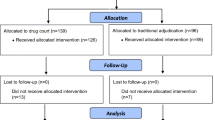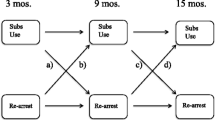Abstract
Support for the effectiveness of substance abuse treatment to reduce substance use and recidivism among populations supervised by the criminal justice system continues to grow in substance abuse and criminal justice literature. Recent studies show that a variety of programs including the Breaking the Cycle program and drug courts appear to result in improved outcomes for offenders. In this paper, we examine the effect of non-residential substance abuse treatment on arrest. Our data are for almost 134,000 ‘drug-involved’ individuals sentenced to probation in Florida between July 1995 and June 2000. Nearly 52,000 of these individuals received non-residential substance abuse treatment, while 81,797 did not. Our approach is a methodologically simple one that entails stratifying our data by treatment status, estimating logit and negative binomial models of arrest for each of the two datasets, and then applying each model to both datasets. This approach, which requires that both groups include subjects for whom treatment is appropriate, is analogous to using regression models to predict outcomes for new values of independent variables. For each observation in the dataset, we use the models to predict the expected outcomes for each individual under two scenarios – receiving non-residential treatment and receiving no treatment. Summing over these individual estimates provides an estimate of the total numbers of arrests that would be expected under different levels of population exposure to treatment. Results suggest that non-residential treatment reduced both the expected numbers of individuals who recidivated (i.e., were arrested) and the expected total numbers of arrests in the 12 and 24 months following placement on supervision.
Similar content being viewed by others
References
Anglin, D. M., Longshore, D., Turner, S., McBride, D., Inciardi, J. & Prendergast, M. (1996). Studies of the functioning and effectiveness of Treatment Alternatives to Street Crime (TASC) programs: Final report.
Banks, D. & Gottfredson, D. C. (2003). The effects of drug treatment and supervision on time to rearrest among drug treatment court participants. Journal of Drug Issues 33(2), 385–412.
Belenko, S. (2001). Research on drug courts: A critical review 2001 update. The National Center on Addiction and Substance Abuse.
Berk, R. A. (1987). Causal inference as a prediction problem. In D. M. Gottfredson & M. Tonry (Eds.), Prediction and classification: Criminal justice decision making (pp. 183–200). Chicago: The University of Chicago Press.
Bonta, J., Law, M. & Hanson, K. (1998). The prediction of criminal and violent recidivism among mentally disordered offenders: A meta-analysis. Psychological Bulletin 123, 123–142.
Brewster, M. P. (2001). An evaluation of the Chester County (PA) Drug Court Program. Journal of Drug Issues 31(1), 177–206.
Bureau of Justice Statistics. (1995). Characteristics of adults on probation, 1995. (Publication No. NCJ 164267). Washington, DC: Department of Justice, Bureau of Justice Statistics.
Bureau of Justice Statistics. (2003a). Probation and parole in the United States, 2002. (Publication No. NCJ 201135). Washington, DC: Department of Justice, Bureau of Justice Statistics.
Bureau of Justice Statistics. (2003b). Prisoners in 2002. (Publication No. NCJ 200248). Washington, DC: Department of Justice, Bureau of Justice Statistics.
Chanhatasilpa, C., MacKenzie, D. L. & Hickman, L. J. (2000). The effectiveness of community-based programs for chemically dependent offenders: A review and assessment of the research. Journal of Substance Abuse Treatment 19, 383–393.
Deschenes, E. P., Moreno, K. & Condon, C. (2001). Success of drug court participants: Central and South Justice Centers Superior Court of Orange County, California.
Falkin, G. P., Strauss, S. & Bohen, T. (1999). Matching drug-involved probationers to appropriate drug interventions: A strategy for reducing recidivism. Federal Probation 63(1), 3–8.
Fielding, J. E., Tye, G., Ogawa, P. L., Imam, L. J. & Long, A. M. (2002). Los Angeles County drug court programs: Initial results. Journal of Substance Abuse Treatment 23(3), 217–224.
Finigan, M. (1996). Societal outcomes and cost savings of drug and alcohol treatment in the state of Oregon. Report prepared for Office of Alcohol and Drug Abuse Programs, Oregon Department of Human Resources, and Governor’s Council on Alcohol and Drug Abuse Programs.
Flynn P. M., Craddock, S. G., Hubbard, R. L., Anderson, J. & Etheridge, R. M. (1997). Methodological overview and research design for DATOS. Psychology of Addictive Behaviors 11(4), 230–243.
Fulton, B., Latessa, E., Stichman, A. & Travis, L. (1997). The state of ISP: Research and policy implications. In R. P. Corbett, Jr. & M. K. Harris (Eds.), Federal Probation 61(4), 65–75.
Gendreau, P., Goggin, C. & Little, T. (1996). Predicting adult offender recidivism: What works! (User Report No. 1996-07). Ottawa: Department of the Solicitor General of Canada.
Gendreau, P., Goggin, C., Cullen, F. T. & Andrews D. A. (2000). The effects of community sanctions and incarceration on recidivism. Forum on Corrections Research 12(3), 10–13.
Glaze, L. (2003) Probation and parole in the United States, 2003. (Publication No. NCJ 205336). Washington, DC: Department of Justice, Bureau of Justice Statistics. http://www.ojp.usdoj.gov/bjs/pub/pdf/ppus03.pdf.
Gottfredson, D. C. & Exum, M. L. (2002). The Baltimore city drug treatment court: Oneyear results from a randomized study. Journal of Research in Crime and Delinquency 39(3), 337–356.
Harrell, A. (1998). Drug courts and the role of graduated sanctions. (Publication No. NCJ 169597). Washington, DC: National Institute of Justice.
Hubbard, R. L., Rachael, J. V., Craddock, S. G. & Cavanaugh, E. (1984). Treatment outcome prospective study (TOPS): Client characteristics and behaviors before, during, and after treatment (DHHS Publication No. [ADM] 84-1349). In F. Tims & J. Ludford (Eds.), Drug abuse treatment evaluation: Strategies, progress, and prospects (NIDA Monograph No. 51) (pp. 29–41). Rockville, MD: National Institute on Drug Abuse.
Hubbard, R. L., Craddock, S. G., Flynn, P. M., Anderson, J. & Etheridge, R. M. (1997). Overview of 1-year follow-up outcomes in the Drug Abuse Treatment Outcome Study (DATOS). Psychology of Addictive Behaviors 11(4), 261–278.
Lattimore, P.K. (July 1999). Effectiveness of residential drug treatment for Florida probationers. Paper presented at the Annual Conference on Criminal Justice Research and Evaluation: Enhancing Policy and Practice, Washington, DC.
Lattimore, P. K., Krebs, C. P., Cowell, A. J. & Koetse, W. (2004). Alternative approaches to the analysis of large, administrative criminal justice databases. Paper presented at the 2004 American Society of Criminology Conference, Nashville.
Linster, R. L. (1999). Evaluation of Florida’s residential treatment program prison diversion program, Final report. Washington, DC: Unpublished final report submitted to the National Institute of Justice.
Linster, R. L., Lattimore, P. K. & Dougherty, K. (1998). Residential drug treatment for Florida probationers: Preliminary findings. Paper presented by P. Lattimore at the American Probation and Parole Association Winter Training Institute, Orlando, FL.
Lurigio, A. J. (2000). Drug treatment availability and effectiveness: Studies of the general and criminal justice populations. Criminal Justice and Behavior 27, 495–528.
Martin, S. S., Butzin, C. A. & Inciardi, J. (1995). Assessment of a multi-state therapeutic community for drug involved offenders. Journal of Psychoactive Drugs 27, 109–116.
Miethe, T., Lu, H. & Reese, E. (2000). Reintegrative shaming and recidivism risks in drug court: Explanations for some unexpected findings. Crime and Delinquency 46(4), 522–541.
Oregon Department of Corrections. (1994). Comparison of outcomes and costs: Residential and outpatient treatment programs for inmates – alcohol and drug, mental health, sex offender, and social skills treatment. Salem, OR: Oregon Department of Corrections, Research and Evaluation Unit.
Paparozzi, M. (1999). Evaluation of intensive supervision programs (ISP) in Montreal and Toronto. Unpublished manuscript.
Pelissier, B., Wallace, S., O’Neil, J. A., Gaes, G. G., Camp, S., Rhodes, W. & Saylor, W. (2001). Federal prison residential drug treatment reduces substance use and arrests after release. American Journal of Drug and Alcohol Abuse 27(2), 315–337.
Petersilia, J. (1998). A decade of experimenting with intermediate sanctions: What have we learned? Federal Probation 62(2), 3–9.
Prendergast, M. L., Anglin, M. D. & Wellisch, J. (1995). Up to speed: Treatment for drugabusing offenders under community supervision. Federal Probation 59(4), 66–75.
Prendergast, M. L., Wellisch, J. & Wong, M. M. (1996). Residential treatment for women parolees following prison-based drug treatment: Treatment experiences, needs, and service outcomes. Prison Journal 76, 253–274.
Rhodes, W. & Gross, M. (1997). Case management reduces drug use and criminality among drug-involved arrestees: An experimental study of an HIV prevention intervention. A final summary report presented to the National Institute of Justice and the National Institute on Drug Abuse.
Rhodes, W., Pelissier, B., Gaes, G. G., Saylor, W., Camp, S. & Wallace, S. (2001). Alternative solutions to the problem of selection bias in an analysis of federal residential drug treatment programs. Evaluation Review 25(3), 331–369.
Simpson, D., Joe, G., Broome, K., Hiller, M., Knight, K. & Rowan-Szal G. (1997a). Program diversity and treatment retention rates in the Drug Abuse Treatment Outcome Study (DATOS). Pyschology of Addictive Behaviors 1194, 279–293.
Simpson, D., Joe, G. W., Rowan-Szal, G. A. & Greener, J. M. (1997b). Drug abuse treatment process components that improve retention. Journal of Substance Abuse Treatment 14(6), 565–572.
Simpson, D., Joe, G. W. & Rowan-Szal, G. A. (1997c). Drug abuse treatment retention and process effects on follow-up outcomes. Drug and Alcohol Dependence 47(3), 227–235.
Stephan, J. J. (2004). State prison expenditures, 2001. (Publication No. NCJ 202949). Washington, DC: Department of Justice, Bureau of Justice Statistics. http://www.ojp.usdoj.gov/bjs/pub/pdf/spe01.pdf.
Truitt, L., Rhodes, W. M., Seeherman, A. M., Carrigan, K. & Finn, P. (March 2000). Phase I: Case studies and impact evaluations of Escambia County, Florida and Jackson County, Missouri drug courts. Cambridge, MA: Abt Associates.
Turner, S., Longshore, D., Wenzel, S., Deschenes, E., Greenwood, P., Fain, T., Harrell, A., Morral, A., Taxman, F., Igushi, M., Greene, J. & McBride, D. (2002). A decade of drug treatment court research. Substance Use and Misuse 37(12–13), 1489–1527.
Van Stelle, K. R., Mauser, E. & Moberg, D. P. (1994). Recidivism to the criminal justice system of substance-abusing offenders diverted into treatment. Crime and Delinquency 40, 175–196.
Vito, G. F., Wilson, D. G. & Holmes, S. T. (1993). Drug testing in community corrections: Results from a four-year program. Prison Journal 73, 343–354.
Weisburd, D., Petrosino, A. & Mason, G. (1993). Design sensitivity in criminal justice experiments. In M. Tonry (Ed.), Crime and justice: A review of research, (Vol. 17, pp. 337–379). Chicago: University of Chicago Press.
exler, H. K., Graham, W. F., Koronowski, R. & Lowe, L. (1995). Evaluation of amity inprison and post-release substance abuse treatment programs. Washington, DC: National Institute of Drug Abuse.
Wolfe, E., Guydish, J. & Termondt, J. (2002). A drug court outcome evaluation comparing arrests in a two year follow-up period. Journal of Drug Issues 32(4), 1155–1172.
Author information
Authors and Affiliations
Corresponding author
Additional information
**RTI is an independent organization dedicated to conducting innovative, multidisciplinary research that improves the human condition.
Rights and permissions
About this article
Cite this article
Lattimore, P.K., Krebs, C.P., Koetse, W. et al. Predicting the effect of substance abuse treatment on probationer recidivism. J Exp Criminol 1, 159–189 (2005). https://doi.org/10.1007/s11292-005-1617-z
Published:
Issue Date:
DOI: https://doi.org/10.1007/s11292-005-1617-z




